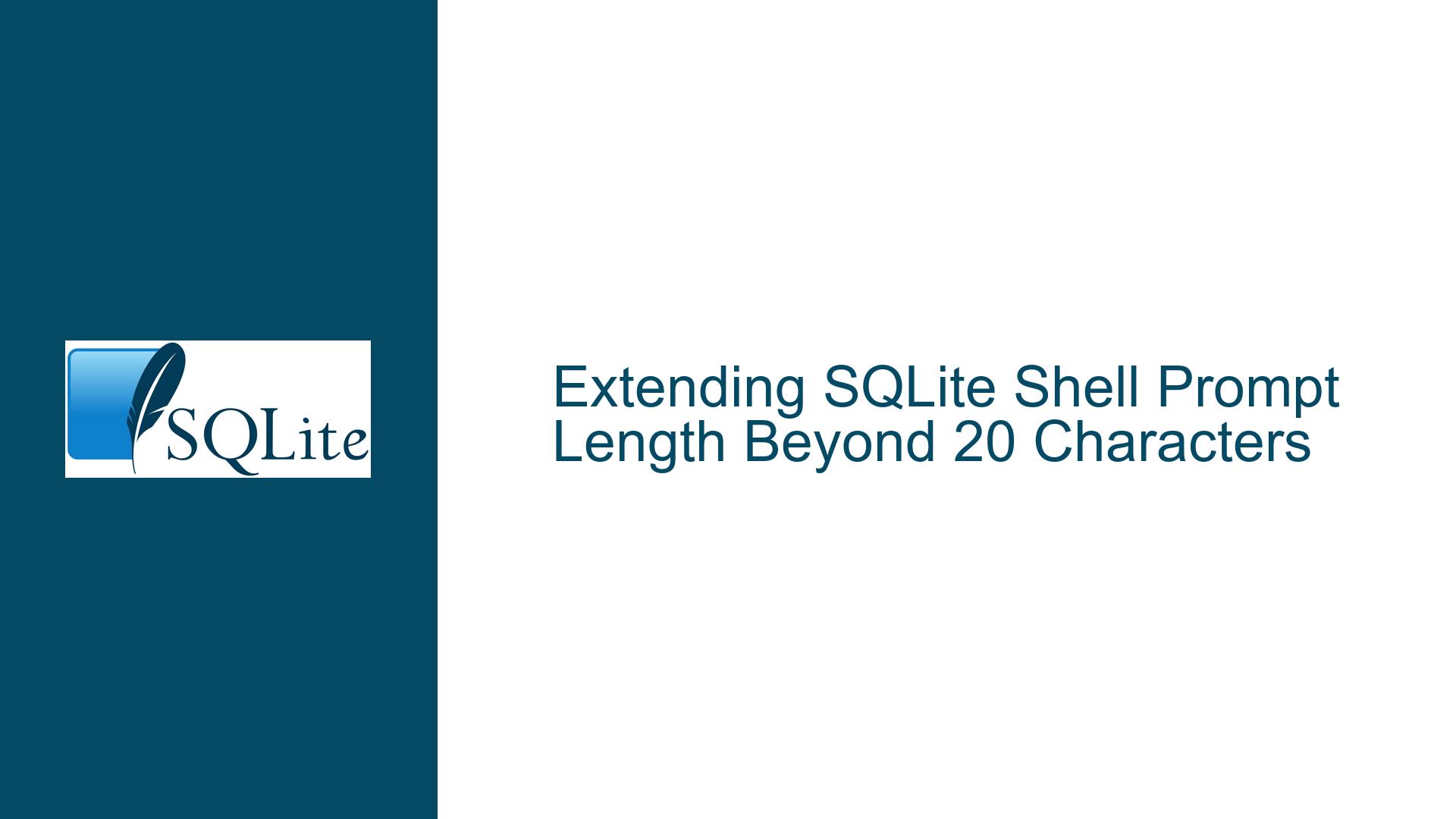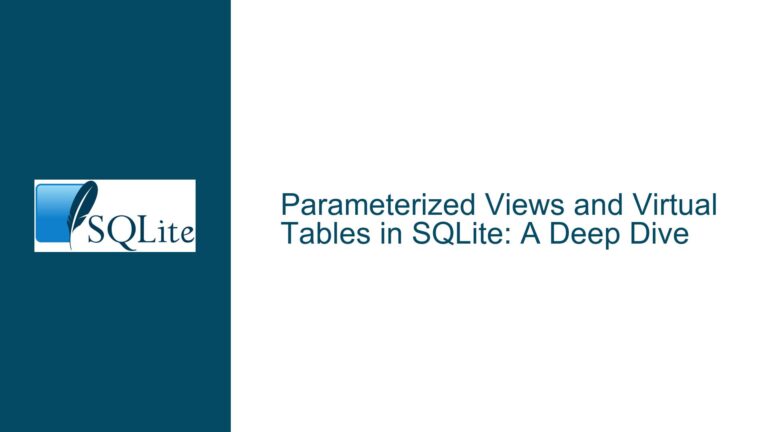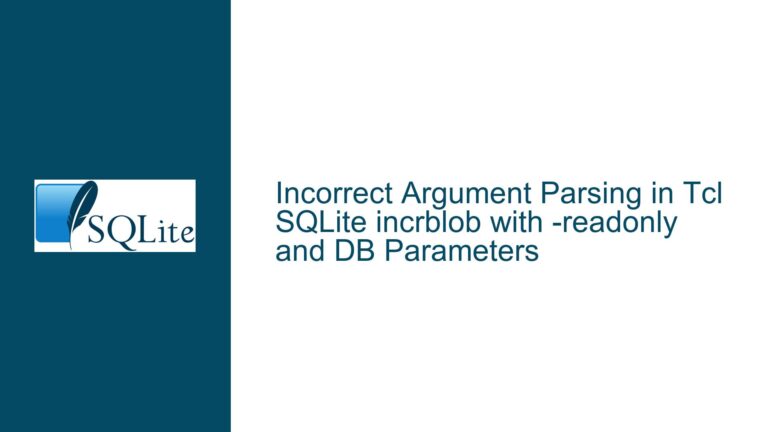Extending SQLite Shell Prompt Length Beyond 20 Characters
SQLite Shell Prompt Length Limitation and Its Impact on Usability
The SQLite shell, a powerful command-line interface for interacting with SQLite databases, has a built-in limitation on the length of the prompt that can be set using the .prompt command. By default, the maximum length of the prompt is restricted to 20 characters. This limitation can be particularly frustrating for users who wish to customize their prompt to include additional information, such as the full path of the database file or color-coded text for better visibility in a terminal environment.
The 20-character limit is enforced by a static buffer defined in the SQLite shell’s source code. This buffer is allocated at compile time, and any attempt to set a prompt longer than 20 characters results in truncation. This design decision, which dates back to 2002, was likely made to conserve memory and simplify the code. However, modern use cases often require more flexibility, especially when dealing with long database filenames or when incorporating control characters for terminal customization.
The impact of this limitation is twofold. First, it restricts the ability to include meaningful information in the prompt, such as the full path of the database file. This can be particularly problematic when working with multiple databases in different directories, as the prompt may not provide enough context to distinguish between them. Second, it limits the ability to use terminal control characters for customization, such as changing the color of the prompt. These control characters can consume a significant portion of the available 20 characters, leaving little room for the actual prompt text.
Static Buffer Allocation and the Need for Recompilation
The root cause of the 20-character prompt limitation lies in the way the SQLite shell handles the prompt string. The prompt is stored in a statically allocated buffer, which is defined in the shell.c.in source file. The size of this buffer is set by the PROMPT_LEN_MAX macro, which is currently defined as 20. This means that the buffer can only hold up to 20 characters, and any attempt to set a longer prompt will result in truncation.
The use of a static buffer for the prompt string is a design choice that simplifies memory management but comes at the cost of flexibility. Since the buffer size is fixed at compile time, changing it requires modifying the source code and recompiling the SQLite shell. This can be a significant barrier for users who are not familiar with the build process or who do not have the necessary tools installed on their system.
One potential solution to this limitation is to replace the static buffer with dynamically allocated memory. This would allow the prompt string to be resized at runtime, providing greater flexibility for users who need longer prompts. However, this approach would require more complex memory management and could introduce new issues, such as memory leaks or fragmentation. Additionally, it would represent a significant change to the SQLite shell’s codebase, which would need to be carefully tested to ensure compatibility with existing features and use cases.
Implementing a Longer Prompt: Recompilation and Workarounds
For users who need a longer prompt, the most straightforward solution is to modify the PROMPT_LEN_MAX macro in the shell.c.in source file and recompile the SQLite shell. This process involves downloading the SQLite source code, editing the relevant line in the source file, and then building the shell using the appropriate tools for your platform. While this approach requires some technical knowledge, it provides a permanent solution that allows for prompts of any length.
Here is a step-by-step guide to recompiling the SQLite shell with a longer prompt:
Download the SQLite Source Code: The first step is to obtain the SQLite source code. This can be done by cloning the SQLite repository or downloading a snapshot from the official website.
Edit the
shell.c.inFile: Locate theshell.c.infile in the source tree and open it in a text editor. Find the line that defines thePROMPT_LEN_MAXmacro, which should look something like this:#define PROMPT_LEN_MAX 20Change the value of
PROMPT_LEN_MAXto the desired maximum prompt length. For example, to allow prompts of up to 80 characters, modify the line as follows:#define PROMPT_LEN_MAX 80Recompile the SQLite Shell: After modifying the source code, the next step is to recompile the SQLite shell. This process varies depending on your platform and build environment. On Unix-like systems, you can typically use the following commands:
make clean make sqlite3This will rebuild the SQLite shell with the new prompt length limit.
Test the New Prompt: Once the shell has been recompiled, you can test the new prompt length by setting a longer prompt using the
.promptcommand. For example:./sqlite3 /path/to/database.db .prompt '/path/to/database.db> 'If the recompilation was successful, the prompt should now display the full path without truncation.
For users who are unable or unwilling to recompile the SQLite shell, there are a few workarounds that can provide some of the functionality of a longer prompt. One such workaround is to use the terminal’s title bar to display the database name or path. This can be done using the .shell title command in the SQLite shell, which sets the title of the terminal window. While this approach does not change the prompt itself, it provides a way to display additional information in a visible location.
Another workaround is to use the -cmd option when launching the SQLite shell to set a custom prompt that includes a newline. This allows the prompt to span multiple lines, effectively increasing the amount of information that can be displayed. For example:
sqlite3 -cmd '.prompt "sqlite\n> "' example.db
This command sets a two-line prompt, with the first line displaying "sqlite" and the second line displaying ">". While this does not increase the maximum length of the prompt, it allows for more complex prompts that can include additional information.
In conclusion, the 20-character prompt length limitation in the SQLite shell is a legacy design choice that can be overcome through recompilation or workarounds. While recompiling the shell provides the most flexible solution, workarounds such as using the terminal title bar or multi-line prompts can offer some relief for users who need more information in their prompt. As SQLite continues to evolve, it may be worth reconsidering the default prompt length to better accommodate modern use cases.






